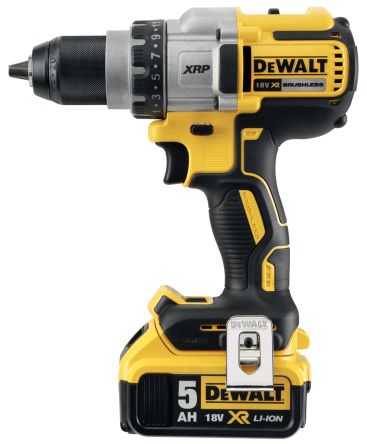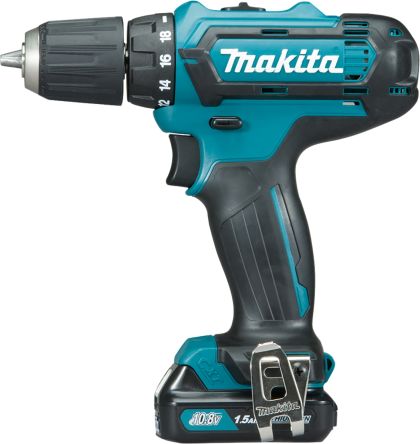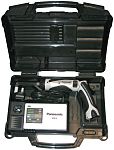|
|
What are cordless drills?
Cordless drills work on rechargeable batteries, allowing the user to insert a battery pack and instantly have an operating drill without a power cable.A cordless drill is a versatile power tool, because as long as the battery is charged the drill can be used anywhere without having to work near an electrical outlet.
What are cordless drills used for?
Cordless drills are mostly used for replacing screwdrivers. These tools are used in conjunction with drill bits, which are typically rotating cutting tools used to make holes. Using the relevant bit, cordless drills can also rotate counterclockwise, ideal for removing screws as well as drilling them in.
The right drill bit will vary depending on the task at hand and they come in different shapes and sizes; with sizes referring to their diameter. Here are some of the different types of drill bits and the materials they should be used for:
-
- Twist drill bit – light metal, wood, plastic, metal, ceramic, masonry
- Masonry drill bit – bricks, concrete, stone
- Spearpoint drill bit – glass, ceramic
- Bullet pilot point drill bit – wood
- Countersink drill bit – metal, wood
- Tile/diamond drill bit – masonry, porcelain
- Flat wood drill bit – wood
- Hole saw drill bit – wood, metal
- Forstner drill bit – wood
- Auger drill bit – wood
- Spade drill bit – wood
- Plug cutter drill bit – wood
- Brad point drill bit – wood
- High-speed steel (HSS) drill bit – wood, light metals, plastic, fibreglass
- Step drill bit – thin materials, metal
- Cobalt drill bit – steel, iron
- Slotted drive system or slotted drive shaft (SDS) drill bit – stone, concrete
One of the most common uses for this power tool is drilling pilot holes in wood which might split. That’s because there’s a risk of a screw digging into the wood and separating the grain – particularly if the screw is large. A cordless drill with a bit one size smaller than the diameter of the screw can drill a pilot hole before the screw is inserted, which helps reduce wood splits.
With hole saw bits, cordless drills are also used as saws for cutting out holes for doorknobs, sinks, drains and other round holes.
As well as this, drywall installation is a common use for cordless drills. Installing drywall requires lifting and holding large panels in place before inserting drywall screws into the studs beneath the wall. That’s why workers often carry cordless drills on their tool belts for easy access.
The cordless hammer drill, a type used specifically for drilling bolts into concrete, incorporates a slight vibration with the strong rotating action of the drill. A cordless hammer drill is essential for installing any type of screw into concrete.
Which is best, cordless or corded drills?
Cordless and corded drills both have their advantages and disadvantages. Here are the pros and cons for each type of tool:
Cordless drills – pros
-
- Convenience – one of the biggest selling points of cordless drills compared to their corded counterparts is the convenience of being portable because they don’t require electric supply. They can move with the user and are ideal for quick fixes and hard-to-reach places. Plus, with an extra battery always charging, they’re never without power. What’s more, by not having to worry about cords getting in the way this can help to reduce hazards and risks in the workplace.
- Extra features – many cordless drills are produced with a variety of features such as a reversible drive, a manually adjustable clutch and magnetised drill bits and multiple speeds.
- Multiple uses for battery – a huge benefit of today’s cordless tools is that the same battery can be used in other tools, such as a circular saw, impact driver and much more. Most manufacturers make great combo kits that provide a couple of batteries and a charger. The batteries for cordless drills come in different sizes ranging from as low as 6 volts all the way up to 28 volts. The most popular choice is either the 12V, the 18V or the 20V batteries. The lower the voltage, the less powerful the drill.
- Storage – as well as their portability, cordless power tools are typically easier to store than corded ones. They can be placed in drawers or on shelves and often come with individual storage containers to house the tool and its accompanying batteries.
Cordless drills – cons
-
- Constant power – an advantage to corded drills is they’re linked to a continuous electricity supply, so they never run out of power. Their performance won’t falter as a cordless tool will when the battery starts reducing.
- Torque – although extremely high-quality cordless drills are available, corded models are a more reliable means of drilling and driving. The twisting force is powered by a constant flow of electricity, so there aren’t limitations in terms of voltage.
- Bulk and weight – the convenience of an attached battery means extra weight and bulk compared to corded tools.
- Cost – it’s important to have a backup battery in case one goes flat in the middle of a job, which can be costly. Eventually, the batteries must also be replaced which can be even more expensive.
- Long-term maintenance – cordless drills are ideal when intended to be used regularly. However, if not used often the best option could be a corded tool as leaving a cordless one to sit for a long time without use can damage its battery.
Corded drills – pros
-
- Size, weight and handling – corded drills don’t require heavy batteries, which means they’re often lighter and smaller than cordless drills. For this reason, most professionals take a corded drill with them to jobs, in case they need to get into a restricted spot where a bulkier cordless drill can’t fit.
- Power – corded drills have a power grid that won’t run out of power, while a cordless drill stops working when its battery runs out. Generally, corded drills are more powerful than cordless drills as they have an endless supply from 110 volts of power source.
Corded drills – cons
-
- Lack of convenience – if a job offers no electricity to hook tools up to, then corded drills aren’t very convenient. If working for a customer, it means relying on their power to do the job which isn’t always ideal.
- Restricted mobility – the cord can restrict mobility, as it keeps the tool tethered to the wall; even with an extension cord. The power cords also create a tripping hazard which wouldn’t be a concern with a cordless drill. Due to this tripping hazard, the lead can get damaged over time and has the potential to give off an electric shock, if not checked for damage on a regular basis.
Almost all cordless power tools on the market now come with a lithium-ion battery which is capable of holding a lot of power that doesn’t diminish over time if the tool isn’t used. Some of the high-spec drills come with a fast charger.


